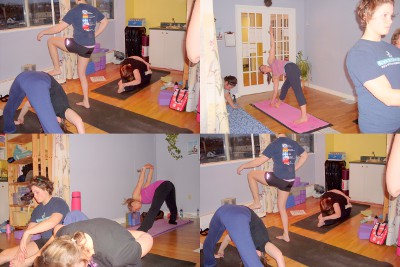This is the third of a four part series of articles about Mysore classes.
Most people that I talk to that have not been to a Mysore class already find the thought of going to one scary. I believe that this is because a Mysore class is new to them and they do not know what a Mysore class is; the benefits of a Mysore class are and the etiquette to follow while in the class.
In the previous article we talked about the benefits of a Mysore class.
In this article we will talk about the etiquette to follow in a Mysore style class.
The complete list of articles is:
- Part I – What is a Mysore Class
- Part II – What are the benefits of a Mysore class
- Part III – What is the Etiquette in a Mysore class
- Part IV – Yes but . . .
Part III – What is the Etiquette in a Mysore class
Arrival and Departure
First time – If this is your first Mysore class or the first time that you are taking a class with this teacher take a moment to introduce yourself to the teacher and make them aware of any limitations you may have with your practice. The teacher will appreciate this and will be better able to assist you.
Enter the room quietly – Open and close the door to practice room quickly and quietly. We want to keep the temperature in the room constant. We do not want any cooling breezes.
Find an available space for you to use – If there is no available space, quietly ask the teacher where you should setup your mat. The teacher will ask other people to move if there is still space. The teacher may ask to you wait until someone finished and left the room before you can setup and start your own practice. Take this an opportunity to practice your meditation
Set your mat up quietly and gently on the floor – Do not stand and fling your mat out on to the floor. This will make a big noise that will cause people to be startled and lose their concentration. It will also create a breeze that can cause people to become chilled and distracted.
Leave the room quietly – Clean your mat and roll it up quietly. Leave the room without disturbing the other people in the room. Open and close the door quickly but quietly. We want to keep the heat in the room and prevent anyone from becoming chilled.
Once again the emphasis is on not disturbing the other people’s concentration on their practice. A loud noise, talking, a cooling breeze can be a problem for some people.
Earlier start or later finish – If for some reason you want to start your practice before the usual start time or you want to finish after the end time, you need to talk to the teacher to determine if it will be okay for you to do so.
Your Practice
Cheat sheets – Some teachers do not permit the use of written posture lists or posture charts in the practice room. You should check with the teacher first before you start to use one. Other teachers will allow you to use these sheets with the expectation that you will eventually no longer need them.
The next posture is ? – If you should forget what posture is next there are a few ways to resolve this: Review the postures that you have just completed in your mind. Usually this will then remind you which one is next; Find someone else in the room that is finishing the posture that you just finished and see which one they are doing next or Ask the teacher for assistance.
Respect your Territorial limits – Try to stay within the limits of your own mat. Sometimes the practice room can become very crowded. Your postures should not be extending into the space next to you. For example you may not have enough room to swing the arms wide in Surya Namaskara A & B or to do a full Chuckrasana. You should modify these postures to fit the space available to you.
There are some exceptions to this. For example the postures Supta Padangusthasana and Uthata Hasta Padangusthasana require you to take the leg to the side. In both of these postures observe the activity around you and try to accommodate your neighbour’s needs as best as possible.
Assistance
Getting the teachers attention – When you want assistance, you need to get the attention of the teacher. You can do this in a couple of ways. Sit quietly in padmasasana (Full Lotus) with your hands together in front of the chest and follow the teacher around the room with your eyes. The teacher will fairly quickly become aware of you and come over to see what needs to be done.
If the first approach does not work, raise your hand to get the teacher’s attention.
Do not call out to the teacher.
When the teacher is assisting you – You should not do a vinyasa between sides. This will save the teacher time and permit them to help you with both sides of the posture. If the teacher requests that you do a vinyasa then of course you will do the vinyasa as requested.
Be considerate of other people’s needs – Do not continuously demand the attention of the teacher for all poses.
Next time
Next time we will talk about some of the objections that people have before they attend their first Mysore class.





I used to use my own sequence in Seths Mysore classes at the Loft. I don’t imagine you’d get away wih that in Mysore, India!